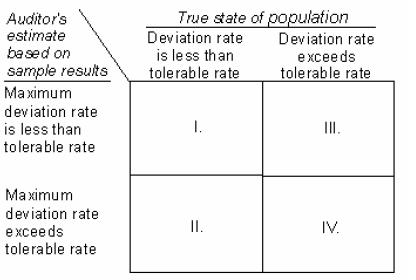AICPA Exam CPA-Auditing Topic 3 Question 12 Discussion
Topic #: 3
The diagram below depicts the auditor's estimated maximum deviation rate compared with the tolerable rate, and also depicts the true population deviation rate compared with the tolerable rate.

As a result of tests of controls, the auditor assesses control risk higher than necessary and thereby increases substantive testing. This is illustrated by situation:
Choice 'b' is correct. If, as a result of test of controls, the auditor assesses control risk higher than necessary, then the maximum deviation rate (auditor's estimate) exceeds the tolerable rate (putting us in row 2) and the deviation rate (true state of the population) is less than the tolerable rate (putting us in column 1). The intersection of column 1 and row 2 puts us in box II.
Choice 'a' is incorrect. The auditor estimates that the maximum deviation rate is more than the tolerable rate.
Choice 'c' is incorrect. The question states that the auditor assessed control risk 'higher than necessary.' This implies that the deviation rate (true state of the population) is actually less than the tolerable rate.
Choice 'd' is incorrect. The question states that the auditor assessed control risk 'higher than necessary.' This implies that the deviation rate (true state of the population) is actually less than the tolerable rate.
Currently there are no comments in this discussion, be the first to comment!